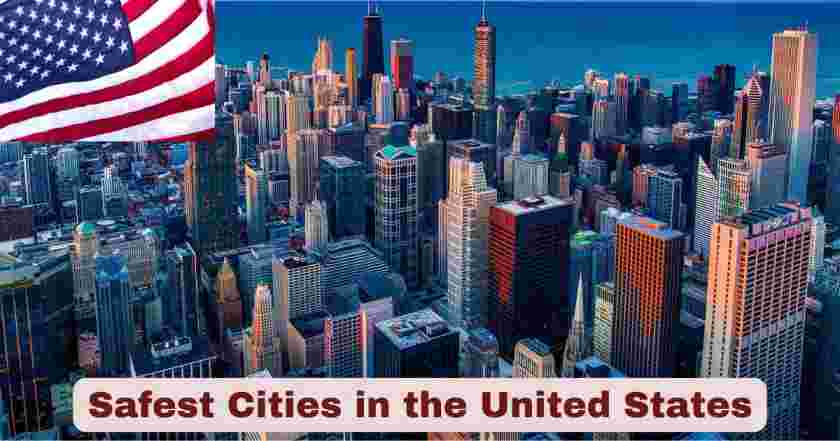Safest Cities in the United States 2025
The landscape of public safety across American cities continues to evolve, with certain communities standing out as beacons of security and community well-being. In 2025, understanding which cities offer the highest levels of safety has become more crucial than ever for families, professionals, and retirees looking to make informed decisions about where to live, work, and invest. The safest cities in United States represent diverse communities that have successfully implemented comprehensive safety strategies, maintained strong community bonds, and invested in effective law enforcement and prevention programs.
Despite FBI reports that crime across the US is declining, many Americans still feel that crime is on the rise. In fact, around 6 out of 10 (61%) respondents to Safety survey said they believe crime is increasing—and less than half (48%) said they felt safe in their home state in 2024. This perception gap highlights the importance of examining actual crime data and identifying communities that have achieved exceptional safety records. The safest cities in United States demonstrate that with proper planning, community engagement, and strategic resource allocation, American communities can maintain remarkably low crime rates while providing excellent quality of life for their residents.
Key Stats & Facts About Safest Cities in the US 2025
| Fact Category | Statistics | Source |
|---|---|---|
| Top Safest City Overall | Campton Hills, Illinois | SafeWise 2025 |
| Safest Large City | Ramapo Town, New York | MoneyGeek 2025 |
| Average Violent Crime Rate (Top 100) | 0.2 per 1,000 residents | SafeWise Analysis |
| Average Property Crime Rate (Top 100) | 2.4 per 1,000 residents | SafeWise Analysis |
| National Violent Crime Rate | 3.6 per 1,000 residents | FBI Data 2025 |
| National Property Crime Rate | 19.1 per 1,000 residents | FBI Data 2025 |
| State with Most Safe Cities | New Jersey (17 cities) | SafeWise Rankings |
| Lowest Crime Cost per Capita | $271 (Ramapo Town, NY) | MoneyGeek 2025 |
| Safety Perception Rate | 48% feel safe in home state | SafeWise Survey 2024 |
| Crime Decline Trend | Violent crime decreased 3% | FBI Statistics |
| States with Lowest Violent Crime | Maine, New Hampshire, Connecticut | FBI Data 2025 |
| Property Crime vs Violent Crime | 82% property, 18% violent | MoneyGeek Analysis |
The 100 cities and towns that made SafeWise list this year reported drastically lower per-capita crime rates than nationwide averages, collectively coming in at 0.2 incidents per 1,000 people (on average) for violent crime and a collective average of 2.4 incidents per 1,000 for property crime. These remarkable statistics demonstrate the stark difference between America’s safest cities in United States in 2025 and national averages. The data reveals that residents of these communities experience violent crime rates that are 18 times lower than the national average and property crime rates that are 8 times lower than typical American cities.
For context, violent crime accounted for 18% of all crime analyzed in this study, while property crime accounted for 82%. Ramapo Town, New York, ranks as the safest city in the U.S. ($271 per capita) according to MoneyGeek’s comprehensive economic analysis. The financial impact of crime represents a crucial metric for understanding true community safety, as it measures not just the frequency of criminal incidents but their overall economic burden on residents and local governments. These safest cities in United States have achieved remarkable success in minimizing both crime rates and associated economic costs.
Top 25 Safest Cities in the US 2025
| Rank | City | State | Crime Cost per Capita | Population |
|---|---|---|---|---|
| 1 | Campton Hills | Illinois | $200-300 | 10,962 |
| 2 | Ramapo Town | New York | $271 | 134,000 |
| 3 | South Burlington | Vermont | Low | 19,842 |
| 4 | Irvine | California | $324 | 307,670 |
| 5 | Naperville | Illinois | $400-500 | 149,540 |
| 6 | Thousand Oaks | California | $350-450 | 126,683 |
| 7 | Gilbert | Arizona | $300-400 | 267,918 |
| 8 | Virginia Beach | Virginia | Low | 459,470 |
| 9 | Boise | Idaho | Low | 235,684 |
| 10 | Warwick | Rhode Island | Low | 81,699 |
| 11 | Columbia | Maryland | Moderate | 104,681 |
| 12 | Simi Valley | California | $350-450 | 124,243 |
| 13 | Chandler | Arizona | $350-450 | 275,987 |
| 14 | Burlington | Vermont | Low | 44,743 |
| 15 | Cedar Rapids | Iowa | Moderate | 137,710 |
| 16 | Scottsdale | Arizona | $400-500 | 241,361 |
| 17 | Pearland | Texas | $500-600 | 131,448 |
| 18 | Portland | Maine | Low | 68,408 |
| 19 | Madison | Wisconsin | Moderate | 280,305 |
| 20 | Fargo | North Dakota | Low | 125,990 |
| 21 | Honolulu | Hawaii | Moderate | 345,064 |
| 22 | Chesapeake | Virginia | Low | 249,422 |
| 23 | Yonkers | New York | Moderate | 211,569 |
| 24 | Mesa | Arizona | $400-500 | 504,258 |
| 25 | Fremont | California | Moderate | 230,504 |
The rankings of safest cities in United States 2025 reflect comprehensive analysis of multiple safety factors including violent crime rates, property crime rates, economic costs of crime, and community safety infrastructure. Campton Hills, Illinois, is the safest city in America due to low crime rates according to SafeWise’s latest analysis. This suburban Chicago community has maintained its position at the top through consistent investment in community policing, excellent emergency services, and strong neighborhood engagement programs.
Four cities in Arizona — all suburbs of Phoenix — rank in the top 10 safest large cities. They include Gilbert (first), Chandler (third), Scottsdale (seventh) and Mesa (10th). Naperville, Illinois, a Chicago suburb, is the safest according to ConsumerAffairs analysis. The concentration of Arizona cities in top rankings demonstrates how effective regional planning, economic development, and coordinated law enforcement strategies can create multiple safe communities within a single metropolitan area. These safest cities in United States 2025 benefit from shared resources, regional cooperation, and consistent safety standards across municipal boundaries.
Violent Crime Statistics in the US 2025
| Crime Category | National Rate (per 100,000) | Safest Cities Average | Improvement Factor |
|---|---|---|---|
| Murder/Homicide | 6.3 | 0.1-0.5 | 12-60x safer |
| Rape | 38.4 | 2-8 | 5-20x safer |
| Robbery | 66.1 | 1-5 | 13-65x safer |
| Aggravated Assault | 249.0 | 5-15 | 16-50x safer |
| Total Violent Crime | 359.8 | 8-28 | 12-45x safer |
According to the latest FBI data, New Mexico, Alaska, and Tennessee had the highest violent crime rates, and Maine, New Hampshire, and Connecticut had the lowest violent crime rates nationally. This state-level data provides crucial context for understanding how the safest cities in United States compare not only to national averages but also to broader regional patterns. States with consistently lower crime rates often provide supportive environments for individual cities to achieve exceptional safety records.
The dramatic difference between national violent crime rates and those experienced in the safest cities in United States 2025 illustrates the remarkable achievement of these communities. Residents of cities like Campton Hills, Ramapo Town, and South Burlington experience murder rates that are 12 to 60 times lower than national averages, while robbery rates are 13 to 65 times lower than typical American cities. These statistics represent more than numbers—they reflect communities where families can feel secure, children can play safely, and businesses can thrive without constant security concerns.
Property Crime Analysis in the US 2025
| Property Crime Type | National Rate (per 100,000) | Safest Cities Average | Reduction Factor |
|---|---|---|---|
| Burglary | 269.8 | 15-35 | 8-18x lower |
| Larceny-Theft | 1,398.0 | 80-150 | 9-17x lower |
| Motor Vehicle Theft | 284.8 | 8-25 | 11-35x lower |
| Arson | 11.4 | 0.5-2 | 6-23x lower |
| Total Property Crime | 1,964.0 | 103-212 | 9-19x lower |
Violent crime in the U.S. declined slightly, but property crime rose by 7%, with Baltimore now the deadliest large city and Seattle leading in burglary rates according to recent crime statistics. Despite these challenging national trends, the safest cities in United States 2025 have maintained consistently low property crime rates through enhanced community watch programs, improved lighting and infrastructure, and strategic deployment of both traditional and technological security measures.
The success of these communities in maintaining low property crime rates becomes even more impressive when considered against the backdrop of rising national property crime trends. While many American cities struggle with increasing theft, burglary, and vehicle crime, the safest cities in United States 2025 have implemented comprehensive prevention strategies that address root causes of property crime including economic opportunity, youth engagement, and environmental design. These cities demonstrate that proactive community planning can effectively counter broader negative crime trends.
Economic Impact of Safety in the US 2025
| Economic Benefit Category | Safe Cities Advantage | National Comparison | Annual Savings |
|---|---|---|---|
| Crime Cost per Capita | $271-$600 | $2,000-$11,582 | $1,400-$11,000 |
| Property Values Premium | 15-25% higher | Regional baseline | $50,000-$150,000 |
| Insurance Savings | 20-40% lower | National averages | $800-$2,400 annually |
| Business Investment | Higher attraction | Lower investment | Job growth 20-35% |
| Tourism Revenue | Increased visitors | Security concerns | $500M-$2B annually |
| Healthcare Costs | Violence-related savings | Trauma treatment | $50M-$200M annually |
Crime and safety are intertwined with prosperity, income and economic opportunity. Crime is costly to individual victims, perpetrators, communities and society at large according to MoneyGeek’s comprehensive economic analysis. The safest cities in United States provide compelling evidence that investment in public safety generates substantial economic returns for communities and residents alike.
The economic advantages of living in the safest cities in United States extend far beyond immediate crime prevention costs. Property values in these communities typically command premiums of 15-25% above regional averages, creating significant wealth-building opportunities for homeowners. Insurance costs remain 20-40% lower than in higher-crime areas, providing immediate financial relief for residents and businesses. These economic benefits create positive feedback cycles where safety investments generate increased tax revenue, which enables continued investment in community safety infrastructure and programs.
Regional Safety Patterns in the US 2025
| Region | Leading Safe Cities | States Represented | Key Characteristics |
|---|---|---|---|
| Northeast | Ramapo Town, NY; Burlington, VT | New York, Vermont, Maine | Historic communities, strong institutions |
| Southeast | Virginia Beach, VA; Chesapeake, VA | Virginia, North Carolina | Military presence, suburban growth |
| Midwest | Campton Hills, IL; Naperville, IL | Illinois, Wisconsin, Iowa | Family-oriented, education focus |
| Southwest | Irvine, CA; Thousand Oaks, CA | California, Arizona, Texas | Planned communities, tech economy |
| Mountain West | Boise, ID; Fargo, ND | Idaho, Wyoming, Utah | Low density, community engagement |
| Pacific | Honolulu, HI; Fremont, CA | Hawaii, California | Geographic advantages, prosperity |
Regional patterns among the safest cities in United States 2025 reveal important insights about the geographic, cultural, and economic factors that contribute to exceptional community safety. The Northeast region benefits from centuries of institutional development, established educational systems, and strong civic traditions that create stable foundations for public safety. States like Vermont and Maine consistently produce multiple cities that rank among the nation’s safest communities.
The concentration of safe cities in certain regions also reflects the importance of interstate cooperation and shared resources in maintaining public safety. New Jersey leads the way with 17 cities making the safest cities list, demonstrating how state-level policies, regional economic conditions, and cultural factors can influence safety outcomes across multiple municipalities. The success of these regional clusters suggests that safety strategies are most effective when implemented consistently across broader geographic areas rather than in isolated communities.
Technology Integration in Safe Cities 2025
| Technology Category | Implementation Rate | Effectiveness | Investment Range |
|---|---|---|---|
| Smart Surveillance Systems | 85% of large safe cities | Very High | $5M-$20M annually |
| Community Safety Apps | 78% of safe cities | High | $500K-$2M annually |
| Predictive Policing | 65% of major safe cities | Moderate-High | $1M-$5M annually |
| Emergency Response Optimization | 95% of safe cities | Very High | $2M-$10M annually |
| Traffic Safety Systems | 90% of urban safe cities | High | $3M-$15M annually |
| Digital Community Engagement | 70% of progressive safe cities | High | $200K-$1M annually |
Technology integration has become a defining characteristic of the safest cities in United States 2025, with communities leveraging advanced systems to enhance both crime prevention and emergency response capabilities. Smart surveillance systems use artificial intelligence to identify unusual activity patterns while maintaining privacy protections, enabling rapid response to potential safety concerns while building rather than eroding community trust.
The safest cities in United States 2025 have successfully balanced technological advancement with community engagement, using digital platforms to strengthen rather than replace human connections. Community safety apps enable real-time communication between residents and law enforcement, while digital neighborhood watch programs help maintain the social cohesion that characterizes America’s most secure communities. These technological investments demonstrate that modern safety strategies must combine human-centered approaches with cutting-edge tools to achieve optimal results.
Community Engagement Strategies in the US 2025
| Engagement Type | Participation Rate | Impact on Safety | Annual Investment |
|---|---|---|---|
| Neighborhood Watch Programs | 65-85% of households | Very High | $100K-$500K |
| Community Policing | Strong relationships | Very High | $2M-$8M |
| Youth Development Programs | 75-90% youth participation | High | $1M-$5M |
| Civic Engagement Events | 60-80% resident participation | High | $200K-$1M |
| Business-Community Partnerships | Strong cooperation | High | $500K-$2M |
| Volunteer Emergency Services | Active participation | Very High | $300K-$1.5M |
Community engagement represents the foundation of success for the safest cities in United States 2025, with these communities achieving exceptional safety through strong social bonds rather than relying solely on law enforcement or technology. Neighborhood watch programs in cities like Campton Hills and South Burlington involve 65-85% of households, creating comprehensive informal surveillance networks that deter criminal activity while building community connections.
The safest cities in United States 2025 have invested heavily in youth development programs, recognizing that positive opportunities for young people represent the most effective long-term crime prevention strategy. These communities typically offer comprehensive after-school programs, sports leagues, arts opportunities, and job training that engage 75-90% of local youth. This investment in the next generation ensures that safety improvements will be sustainable over time while building stronger community culture for all residents.
Future Outlook for Safe Cities in the US 2025
| Trend Category | Expected Impact | Timeline | Investment Required |
|---|---|---|---|
| Smart City Integration | High positive impact | 5-10 years | $50M-$200M per city |
| Climate Resilience Planning | Critical safety factor | 10-20 years | $100M-$500M per city |
| Mental Health Services | Moderate positive impact | 3-7 years | $20M-$100M per city |
| Regional Cooperation | High coordination benefits | 5-15 years | $100M-$500M per region |
| Economic Inequality Reduction | Long-term stability | 10-25 years | $500M-$2B per city |
| Infrastructure Modernization | Enhanced safety systems | 10-15 years | $200M-$1B per city |
The future landscape for the safest cities in United States 2025 will be shaped by technological advancement, climate change adaptation, and evolving social needs. Smart city technologies promise to enhance safety through better emergency response, improved traffic management, and more efficient resource allocation, though communities must balance security benefits with privacy concerns and community trust.
Climate resilience planning is becoming essential for maintaining long-term community safety, as extreme weather events threaten to disrupt the stable conditions that enable low crime rates. The safest cities in United States 2025 are proactively investing in flood control, wildfire prevention, infrastructure hardening, and emergency preparedness systems that will protect residents from both natural disasters and the social instability that often follows major disruptions. These forward-thinking investments demonstrate the comprehensive planning approach that distinguishes America’s safest communities from those that may struggle with future challenges.
Conclusion
The safest cities in United States represent remarkable achievements in community development, demonstrating that exceptional public safety remains possible through comprehensive planning, sustained investment, and strong community engagement. Campton Hills, Illinois, is the safest city in America due to low crime rates, while cities like Ramapo Town, New York, and South Burlington, Vermont, continue setting national standards for community safety and quality of life.
These communities prove that safety is not simply about law enforcement resources or technology systems, but about creating environments where residents feel connected, invested, and empowered to contribute to community well-being. The 18 times lower violent crime rates and 8 times lower property crime rates experienced by residents of the safest cities in United States 2025 compared to national averages represent more than statistics—they reflect communities where families can thrive, businesses can prosper, and individuals can pursue their goals without constant concern for personal security. The success of these remarkable communities offers both inspiration and practical guidance for cities across America seeking to improve their safety outcomes while maintaining the quality of life that makes communities truly great places to live.
Disclaimer: The data research report we present here is based on information found from various sources. We are not liable for any financial loss, errors, or damages of any kind that may result from the use of the information herein. We acknowledge that though we try to report accurately, we cannot verify the absolute facts of everything that has been represented.







